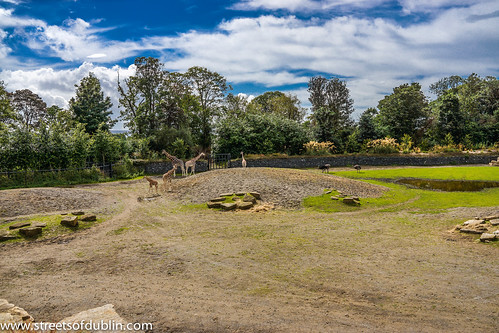
Giraffes (Including The New Baby) - The Streets Of Dublin Project Visits Dublin Zoo, originally uploaded by infomatique.
The Royal Zoological Society of Dublin was established at a meeting held at the Rotunda Hospital on 10 May 1830 and the zoo, then called the Zoological Gardens Dublin, was opened on 1 September 1831.
The animals, 46 mammals and 72 birds, were donated by London Zoo.
The initial entry charge per person was sixpence, which was a sizeable sum at the time and limited admission to relatively wealthy middle-class people. What made Dublin Zoo very different from some of its contemporaries was a decision to reduce the charge to one penny on Sundays. This made a day at the Zoo something that nearly every Dubliner could afford once in a while and it became very popular.
In 1833, the original cottage-style entrance lodge to the zoo was built at a cost of £30. The thatch-roofed building is still visible to the right of the current entrance. In 1838, to celebrate Queen Victoria's coronation, the zoo held an open day - 20,000 people visited, which is still the highest number of visitors in one day.
President of the United States Ulysses Grant (after leaving office) was among the celebrities who came to see Dublin's world-famous lions in the 19th century. The first tearooms were built in 1898.
In 1844 the zoo received its first giraffe, and in 1855 it bought its first pair of lions. These bred for the first time in 1857. Reptiles got their own house in 1876.
On 17 June 1903 an elephant named Sita killed her keeper while he nursed her injured foot. She was put down by members of the Royal Irish Constabulary. Times of trouble and war also caused problems for the zoo. Meat ran out during the Easter Rising of 1916. In order to keep the lions and tigers alive, some of the other animals in the zoo were killed.
A lion named Slats was born in the zoo on 20 March 1919. According to Dublin Zoo: An Illustrated History by Catherine De Courcy it was one of many lions filmed by the Metro-Goldwyn-Mayer film studio in 1928 to be used as their mascot Leo.
Between 1989 and 1990 the financial situation at the zoo became so serious that the council considered closing it. The Government then gave it a meaningful annual grant in line with what happens in other European countries.
The zoo is part of a worldwide programme to breed endangered species. It is a member of the European Endangered Species Programme (EEP), which helps the conservation of endangered species in Europe. Each species supervised by the EEP has a single coordinator that is responsible for the building of breeding groups with the aim of obtaining a genetically balanced population.
Dublin Zoo manages the EEP for the Golden Lion Tamarin and the Moluccan Cockatoo. It also houses members of the species Goeldi’s monkey and the white-faced Saki which are part of EEPs coordinated by other zoos. The focus is on conservation, which includes breeding and protecting endangered species, as well as research, study and education.
No comments:
Post a Comment